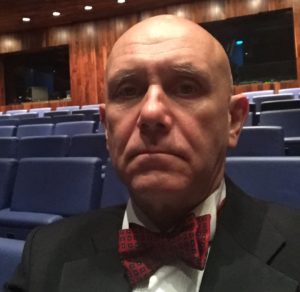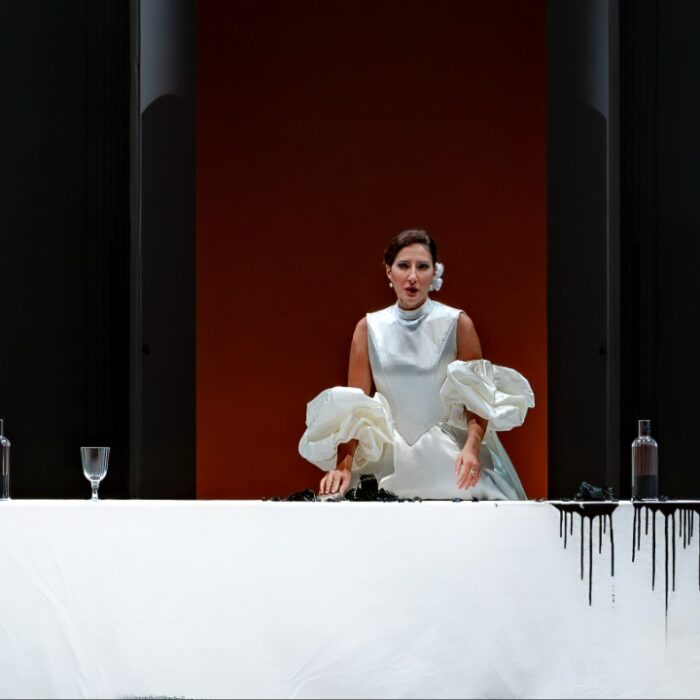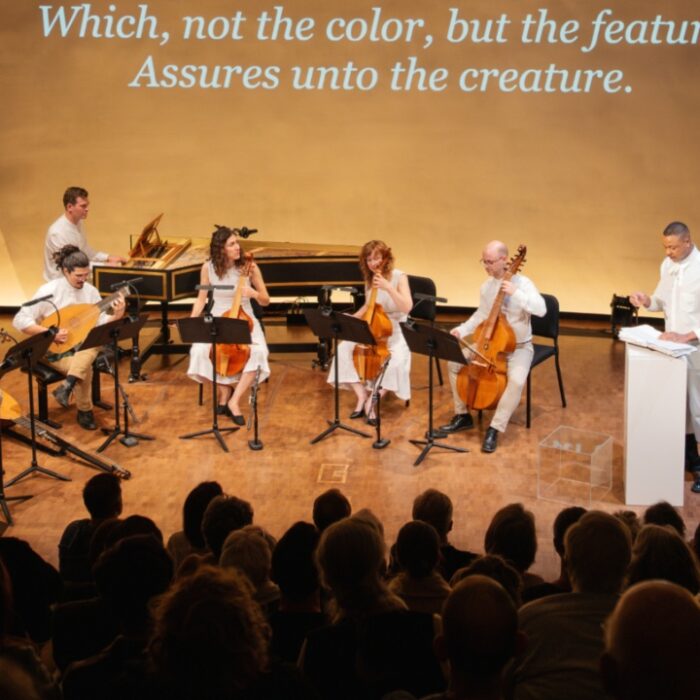
(Photo: Clemens Manser)
In 1637, the San Cassiano theatre opened its doors for the first time with a performance of Francesco Minelli’s “L’Andromeda,” an event that took opera out of the palazzi and drawing rooms of the aristocracy and into the public arena. Within a matter of only a few years, the city was awash with opera houses. Composers and librettists, singers, artist and machinery designers flocked to the city as the art form boomed. Initially, the plots were taken from classical mythology but very quickly morphed into historical narratives with several unrelated plot levels that included characters from all social classes, dispensed with Aristotle’s unities and mixed the serious with the comedic, set against a background of spectacular stage effects, which was described in the program as a ‘fairground baker’s hodgepodge.’
The composer, Francesco Cavalli, who had arrived in Venice at the age of 14 in 1616, rose to become one of the major composers of the period, writing 27 operas, the vast majority of which were for the city’s new public opera houses, including his 1666 work for the Teatro San Salvatore, “Pompeo Magno,” this year’s main presentation at the Bayreuth Baroque Festival.
The narrative, typical of the period, moves between the political, focused on the rivalry between the Consul of Rome, Pompeo, and his prisoner, the King of Pontus, Mitridate; the love intrigues of Sesto and Mitridate’s wife, Issicratea, and Giulia, Servilio and Pompeo, mixed with the low comedy of Delfo, Arpalia and Altrea. The librettist, Nicolò Minato, convincingly managed to weave the unrelated plots while successfully setting up situations for the singers to display their talents in presenting arias with a wide range of emotions and promoting the virtues of loyalty, magnanimity and charity. The opera also presents Venice’s rival, the Roman Republic, in a positive light, not only to please the city’s guest Maria Mancini, wife of the Roman Lorenzo Onofrio, but also as a validation to its own status as a republic and as recognition of the cities’ common ancestry.
Directorial Brilliance
The stage director, Max Cencic, who has created a series of successful productions for the festival since its inauguration in 2020, again showed his directorial brilliance with his insightful, layered and detailed reading of “Pompeo Magno.”
He rejected the idea of setting the piece in Ancient Rome, opting instead for a reading that placed the drama in 17th century Venice, the time of its premiere. After all, while it may superficially relate to Roman history, it is more a reflection of Venice’s pride in itself as a republic and as an artistic, theatrical and musical centre. Many of its characters are recognizable from the Venetian stage and, of course, the work itself is a typical example of the Venetian form of opera.
Together with scenographer Helmut Stürmer and costume designer Corina Gramosteanu, Cencic created a colorful staging that conjured up the atmosphere and images of 17th century Serenissima; there were gondolas and the recognizable façade of the doge’s palace bathed in the warm Venetian light, while Pompeo was presented as the doge, dressed in his traditional robes.
In what proved to be a clever conceit, Cencic promoted the city’s close association with the commedia dell’arte by identifying many of its characters with the opera’s protagonists, so that, for example, Giulia was portrayed as Colombina and Claudio as Pantalone, which immediately defined their general characteristics and further underpinned the opera’s Venetian roots. Gramosteanu’s detailed and inventive costumes made their identification fairly easy.
One of the characteristics that one associates with a Cencic production is the depth and detail he adds to a presentation. Rarely are characters left alone on stage to simply deliver an aria or relegated to an inactive role, standing in the background while other singers perform set pieces; there is always a purpose to their presence! The character of Crasso, for example, has a small singing role but appears onstage frequently, but is never passive. Dressed in a flamboyant, colorful costume with a distinctive mask, cloak, hat and a huge beard, he reacted to Pompeo’s every utterance and thus promoted the Consul’s importance. Supernumeraries are often introduced to pad out a scene, although never in a gratuitous fashion; they always had a purpose. In this instance, Cencic introduced members from the Oh So Small Actors Agency to portray 17th century caricatures of dwarfs, who were used to ridicule and entertain, often containing a lewd sexual aspect, which brilliantly and amusingly brought scenes to life.
It would be almost impossible to overstate the energy, movement and depth of Cencic’s vision, which Stürmer’s sensitive stage designs and Gramosteanu’s striking costumes brilliantly supported.
Lively, Bright & Energetic Performances from the Soloists
In total there were 17 soloists, of which five or six had major roles; even many of the minor roles had significant parts. The overall quality of the singers was high, of whom a number produced outstanding performances.
Countertenor Max Cencic cast himself in the title role of the aging Pompeo, whom he played as confident, aloof and authoritative, and although in his twilight years, he retained a noble air and still possessed the dying embers of his youthful passions; he seemed relieved that he actually was able to step aside from his pursuit of Giulia in favour of Sevilio. His singing was tempered to suit Pompeo’s age, so there was little in the way of explosive vocal displays; rather, it was characterized by delicate phrasing and elegance of expression, in which his emotions were presented clearly yet with restraint.
Soprano Mariana Flores produced a passionate, emotionally compelling and expressively strong interpretation as Mitridate’s wife and Pompeo’s prisoner, Issicratea, presenting her as courageous, haughty and at times even domineering with a noble bearing. She possesses a secure, firm, clear-sounding voice, which can sound strident, forceful and steely but can equally be moulded to appear calm, alluring and elegant. She moves comfortably into her upper register, where she sings securely, with confidence, and is able to sustain the line with ease. Her arias were fashioned to bring out their full meaning. In her Act one aria, “Questi lumi lagrimosi,” for example, she captured the intense sadness of her situation, as she etched her pain into the fabric of every phrase, yet without compromising the beauty of the piece. It was an emotion that she built upon in her Act two aria, “La speranza mi tradisce,” in which she once again gave voice to her suffering, using her pleasing coloratura and imaginative embellishments to capture her pain. Her recitatives were no less powerful: her distress caused by her Act two confrontation scene with Sesto was expertly crafted as she delivered her lines with a fiery intensity, heavily accented and coated with a mixture of fear and defiance.
Tenor Valerio Contaldo’s strong presence allowed him to dominate the stage with a heroic portrait of Mitridate, a man of action, prepared to take risks, who sang and acted out his part with a real swagger. His singing was clear, articulate and expressively powerful with an attractive lyrical quality underpinned by a timbral warmth, which he illustrated beautifully in his aria, “Coetaneo con gl’astri.” In Act two, doubting his wife’s fidelity, he showed off the emotional depth that he is able to bring to his singing in the aria “Tormentosa gelosia,” in which he showed off his excellent phrasing, colorful palette and well-placed accents as he gives voice to his feelings of jealousy. It was a role full of earnest intent that suited his voice. His interactions with the other characters were convincingly fashioned, but it was his killing of the mean-spirited and malicious Arpalia that proved most satisfying.
Soprano Sophie Junker produced an animated, flirtatious performance in the role of Giulia, a relatively small part but with a series of arresting arias, which she delivered with sensitivity and spirit. She possesses a lively, versatile and expressive voice, which she displayed to good effect in her first aria, “So ch’intorno a questo core,” as she danced around the stage singing with freedom while delivering a lively coloratura. Her final aria, “Vilipeso, disprezzato,” was particularly well-presented, in which she captured her sense of loss that she mixed with a defiant edge.
Countertenor Alois Mühlebacher successfully captured the youthful, sincere and naïve qualities of Mitridate and Issicratea’s son, Farnace, with a fresh, enthusiastic vocal presentation that showed off his beautifully crafted phrasing, vocal flexibility and a consistent homogeneity of tone. His elegant delivery lay easily on the ear yet was also successful in expressing his emotional states. He also played the small role of Amore.
A Stunning Performance from Balducci
Countertenor Nicoló Balducci produced a stunning performance as Pompeo’s son, Sesto, in which he brilliantly caught the character’s complex psychological makeup, caused by trying to earn his father’s respect, yet who is still not mature enough to understand his own motivations or to reflect on his own behavior. His vicious treatment of Issicratea, which descended from an aggressive pursuance to violence, threat and attempted rape, was notably at odds with his underlying character, which was essentially noble and refined, and the fact that Mitridate was able to forgive him his actions was not wholly surprising. Vocally, Balducci’s interpretation was equally impressive. Recitatives were delivered with an expressive depth that drove the drama forward and revealed his nuanced character, while his arias allowed him to show off his vocal technique to the full in a series of emotionally powerful and beautifully sung renditions, exemplified by “Io non so se quel sereno,” in which his control, versatility and precision enabled him to deliver complex embellishments and rapid passages of coloratura, while the aria “Date senso a questi marmi,” sung in his jail cell, was beautifully rendered to capture the nuance of his feelings as his singing slowly intensified as his emotions grew more unstable and his inner composure dissolved.
With only a few lines to sing, tenor Jorge Navarro Colorado managed to provide his character, Crasso, with a clearly defined personality.
It is unlikely that Giulio Cesare has ever appeared on stage in which he has been given such a low profile as in “Pompeo Magno.” Nevertheless, baritone Victor Sicard, playing the role, still managed to give him an authoritative personality, in which his firm, resonant projection, rich coloring and vibrant presentation compensated for his lack of exposure.
The countertenor Valer Sabadus engaged enthusiastically with his role as Servilio but was let down by his lack of vocal clarity as he struggled to articulate the Italian text and upset the natural rhythm of the line.
It is possible that tenor Nicholas Scott, playing the role of Claudio, produced one of the rudest and most vulgar portraits of a character to set foot on an opera stage. When conversing with a woman, he would leer at them while playing with a prosthetic phallus positioned indiscreetly between his legs; it was gross! It was, however, also a strong, convincing characterization, which he supported with an animated, lively vocal reading.
Countertenor Kacper Szelazek gave a lively, stereotypical reading of Arpalia, Issicratea’s servant, playing up the comedy at every turn while bringing out her vicious character. His mimicking of an old woman was expertly presented, in which he cleverly curled the voice to capture her unpleasant nature.
Tenor Marcel Beekman produced a lively, high-energy performance as the mad old woman, Altrea, who appeared to spend her whole time on stage, shrieking, whooping and seeking attention, usually at someone else’s expense; every action, every utterance was overdone, with the intention of playing up the comedy of the role, something Beekman proved to be exceptionally good at, aided in no small part by his impressive vocal versatility and talent for mimicking.
Countertenor Dominique Visse, essaying the part of Delfo, often found himself in the presence of Altrea and joined in with the crazy behavior, screeching and mimicking, while pursuing his own agenda.
The four princes, played by countertenors Pierre Lenoir and Angelo Kidoniefs, tenor Yannis Filas and Christos Christodoulou, worked well together with enthusiastic and balanced performances.
The musical director, Leonardo Garcia Alarcon, oversaw a fabulous performance, in which he created a finely tuned, seamless connection between the musicians of the Cappella Mediterranea and the singers to promote a dramatically taut reading that moved easily between the playful comedy and moments of high drama. It was bright, vibrant and inventive. It was also rhythmically exciting, emotionally moving and captured the beauty and accessibility of Cavalli’s melodies, which added a sunny disposition to the performance. His reinterpretation of the final number into a large, lively, joyful and catchy ensemble piece with the entire cast present on stage brought the opera to a spectacular close, which was then encored during the final applause.
It was an absolutely superb performance, one that brought the spirit of mid 17th century Venetian opera truly alive; it was possible to feel the color, the atmosphere and the spirit of the city in the music and its characters! It also validated Cavalli’s reputation as one of the century’s great opera composers. That this was the first performance of the opera in modern times is quite a surprise, but it is unlikely that it will be long before it is taken up by other companies.
Categories
Reviews


